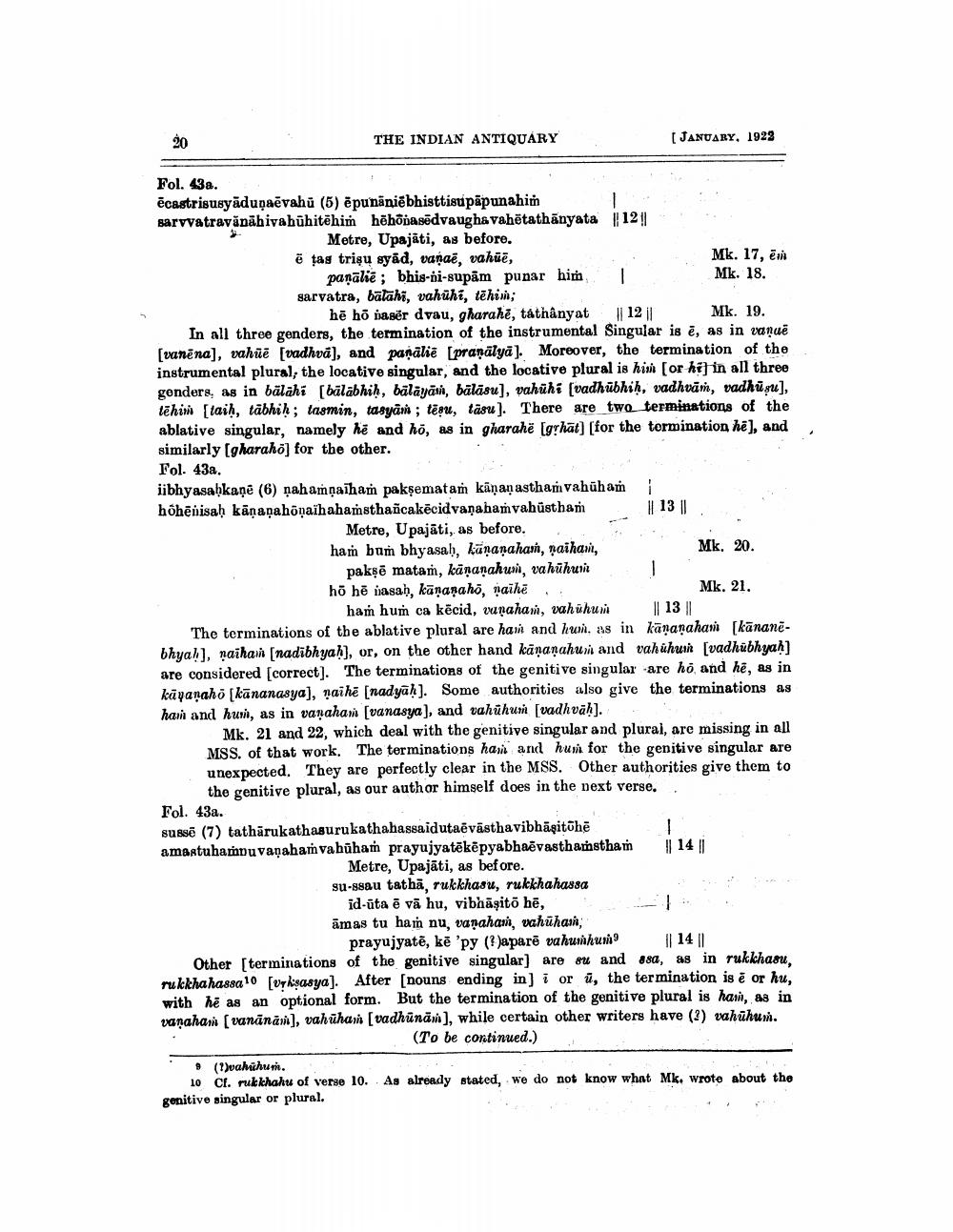________________
THE INDIAN ANTIQUARY
(JANUARY, 1923
Fol. 43a. ēcastrisusyādupaēvahū (5) ēpunāniēbhisttisupäpunahim sarvvatravinähivabūhitēhim hēhovasēdvaugha vahetathānyata |12!
Metre, Upajāti, as before. ē țag triķu syad, vanae, vahüē,
Mk. 17, ēvit panālië; bhis-ni-supām punar hin
Mk. 18. sarvatra, bātāki, vahūhi, tēhis;
hē ho rasēr dvau, gharahé, táthânyat || 12 il Mk. 19. In all three genders, the termination of the instrumental Singular is ē, as in vanue [vanēna), vahuê [vadhva], and paņālie (pranālyā). Moreover, the termination of the instrumental plural, the locative singular, and the locative plural is hin (or hij in all three gonders, as in bälahi (bālābhih, bālāyāni, bālāsu), vahūhi (vadhabhiḥ, vadhvām, vadhuşu), lēhi (taih, tābhik ; tasmin, tasyāns ; tēşu, tasu]. There are two__terminations of the ablative singular, namely he and hö, as in gharahë (grhat) (for the tormination hé), and similarly (gharahõ] for the other. Fol. 43a. iibhyasahkaņē (6) nahamņaiham pakşematam kāņanasthan vahūhami höhēnisah kananahõnaïhahamsthañcakēcidvanahamvahüsthan
|| 13 |. Metre, Upajāti, as before. ham bus bhyasah, kānanahan, naihanit,
Mk. 20. paksē matam, kānanahu, vahūhurit ho hē vasah, kāņaşaho, naihe
Mk. 21. ham hum ca köcid, vunahan, vahühui || 13 | The terminations of the ablative plural are han and hul as in kananahan [kānanëbhyah), naihah (nadibhyah), or, on the other hand kananahusi and vahuhu svadhubhuah] are considered (correct). The terminations of the genitive singular are hô and hê, as in kāyanaho kānanasya), naihe (nadyah). Some authorities also give the terminations as hain and hun, as in vaņahani [vanasya), and vahuhuri vadhväh].
Mk. 21 and 22, which deal with the genitive singular and plural, are missing in all MSS. of that work. The terminations han and hun for the genitive singular are unexpected. They are perfectly clear in the MSS. Other authorities give them to
the genitive plural, as our author himself does in the next verse. Fol. 43a. sussé (7) tathūrukathasurukathahassaidutaēvästhavibhāzitohe amantuhampuvanahavabūham prayujyatēkēpyabhaēvasthamstham
Metre, Upajāti, as before. su-ssau tathā, rukkhasu, rukkhahassa
id-ūta ē vā hu, vibhāşito hē, amas tu hаin nu, vamahaй, сайһай,
prayujyatē, kē 'py (?)aparē vakuuhumo || 14 || Other [terminations of the genitive singular) are su and ssa, as in rukkhasu, rukkhahassa 10 [Urhisasya). After (nouns ending in) i or ū, the termination is ē or hu, with he as an optional form. But the termination of the genitive plural is has, as in vanahan (vanānām), vahūhann [vadhūnām), while certain other writers have (?) vahūhun.
(To be continued.) 9 (1)vahahun.
10 Cf. ruke khaku of verse 10. As already stated, we do not know what Mk. wrote about the genitive singular or plural.
14 |




